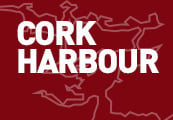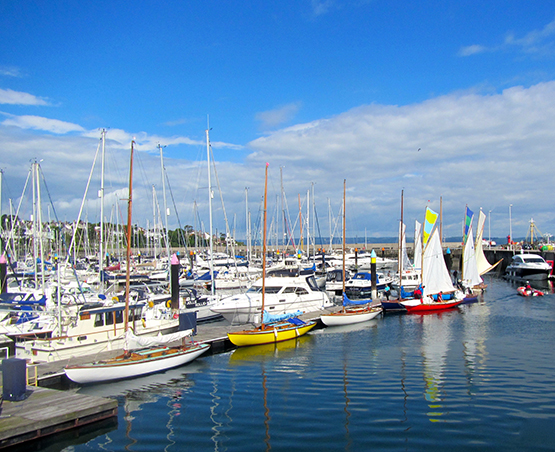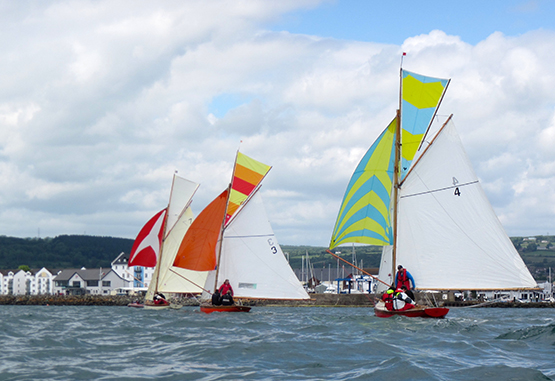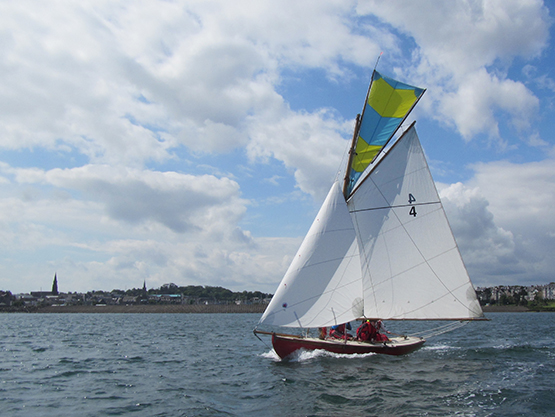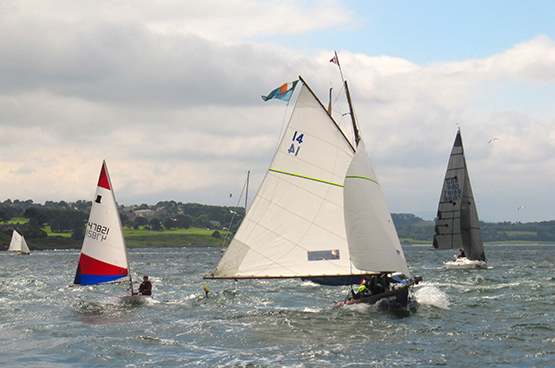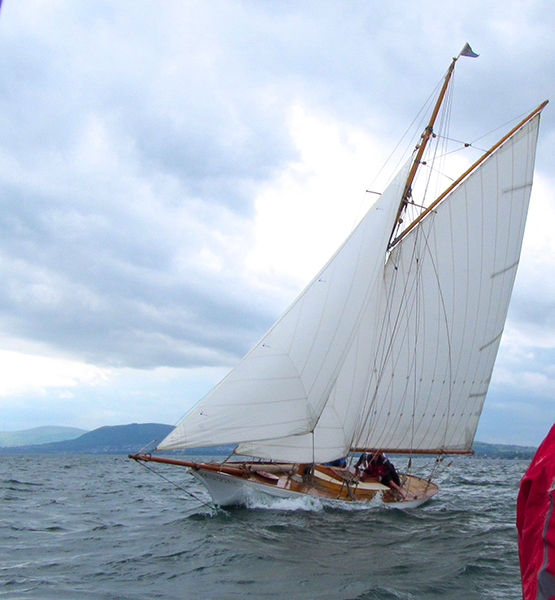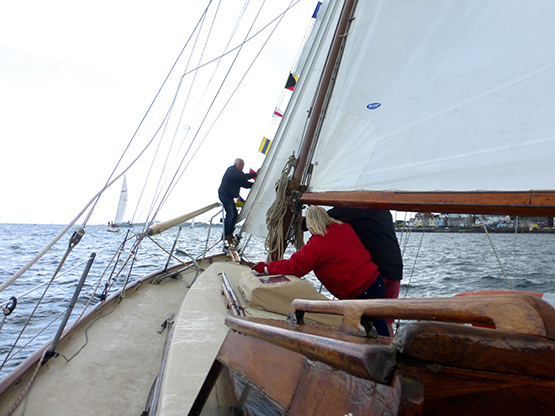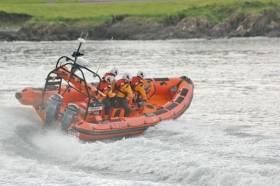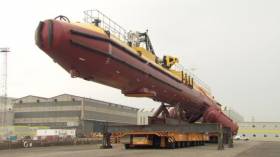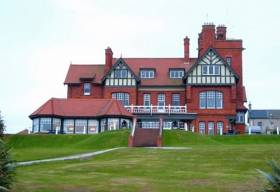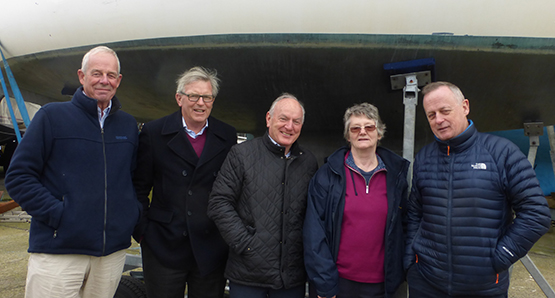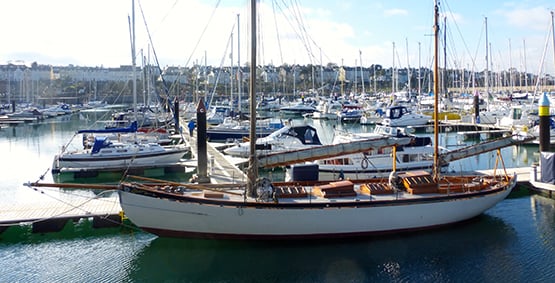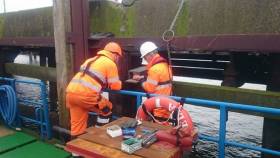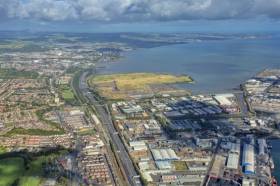Displaying items by tag: Belfast Lough
Afloat.ie’s W M Nixon grabbed only a few hours sleep after his almost continuous coverage of the Volvo Round Ireland Race 2016 before haring off to Bangor in County Down to sail in the RUYC 150th Anniversary Regatta on Saturday June 25th aboard the same boat on which he took part in the same club’s Centenary Regatta in 1966 – and with the same crew. But he arrived at his former home port to find that the defining sailing symbols of his more recent home port of Howth had got there before him…
The amateur yacht designer Walter Boyd of Howth crewed on his father’s 72ft cutter Thalia in the Royal Ulster Yacht Club regatta at Bangor on Belfast Lough in July 1897. A week earlier, the Boyd family had concluded their accumulation of tidy sums in prize money in the Clyde Fortnight with the 1891-vintage Fife-designed Thalia. Ironically, Thalia had been sold away from the Clyde to Judge Boyd of Howth in 1892 at a bargain price, as her original Scottish owners felt she was being out-classed by the new boats from the other Scottish designer, G L Watson. But the Boyd family seemed well able to demonstrate otherwise.
Certainly by 1897 it was Fife who was again in vogue with newer winners like Isolde and Ailsa, and that year saw the advent of the new Fife-designed Belfast Lough One Design Association 25ft LWL Class I boats, built by up-and-coming boatbuilder John Hilditch of Carrickfergus on the north shore of Belfast Lough.
They made a very favourable impression on their debut at Clyde Fortnight in late June and early July 1897 closely observed by, among many others, the Boyd family on Thalia. And after returning to strut their stuff at home at the Royal Ulster regatta in mid-July, four of the BLOD 25s then went on to race for several days in the Dublin Bay regattas, making such a good showing that it inspired the formation of the Dublin Bay 25ft OD Class.
The Dublin boats, with the first appearing in 1898, were of the same hull profile, but with slightly finer sections and built to a much higher specification, with a lead ballast keel as opposed to the Belfast Lough boat’s cheap-and-cheerful cast iron.
Yet even while the pundits of the Clyde, Belfast Lough and Dublin Bay were debating the merits of one against the other, and indeed whether it was even a feasible idea to have a One Design of such a size that she was capable of going offshore, the Howth men returned to their peninsula home, and cogitated among themselves on what they had seen. They were looking for something economical to replace the deathtraps which were the Half Raters they’d been racing for three or four seasons.
Bangor Marina with some of the Mylne-designed Glens from Strangford Lough in the foreground, and jackyard topsails much in evidence on the Howth 17s beyond as they prepare to race across Belfast Lough to their 1898 birthplace of Carrickfergus. Photo: Trish Nixon
The result was that by the end of October 1897, Walter Boyd had produced a design for an able little 17ft LWL, 22.5ft LOA gaff sloop complete with jackyard topsail. An order to build the first five was immediately placed with John Hilditch at Carrickfergus. And by the beginning of April 1898, these new Howth 17s were ready to be sailed the 90 miles to their home port by their notably keen owners. From design finalisation to first race took barely six months, which tells us much about the spirit of the 1890s.
The world has moved on since 1898, but there is still a numerous class of Howth 17s at Howth, including the original five built by John Hilditch at Carrickfergus. In 1998 a flotilla of them returned by road to their birthplace for some decidedly crisp Easter sailing to celebrate their Centenary, and then – the wind being fair – they all made a fast if freezing overnight sailing passage home.
The Return of the Seventeens – approaching Carrickfergus SC on June 23rd 2016, Ian Malcolm’s Hilditch-built Aura (7) leads from Roddy Cooper’s Leila (3, also Hilditch-built) while third lies Class Captain Tom Houlihan in the 1899-built Zaida. Photo: Trish Nixon
Since then, they’ve had further outings to various classic events, with a couple even managing Brest on one occasion, and the Solent Classics on another. But their most impressive outing was in 2003 when no less than 15 boats were moved in a masterclass of logistics to the Glandore Classics. So although the regular annual race programme, which provides them with sixty races each summer at Howth, is the backbone of the class, now and again other possibilities turn up, and for 2016 there was a double offering on Belfast Lough.
There, sailing seems to have suddenly taken off in 1866, as 2016 offered both the 150th Anniversary of Carrickfergus Sailing Club with a special Hilditch Regatta to celebrate the memory of a boatbuilder who was in business for only 24 years from 1889 to 1913, but he was very productive during those years. And it was also the 150th Anniversary – the Sesquicentennial, forsooth – of the Royal Ulster Yacht Club, which had started life as the Ulster Yacht Club in 1866, but thanks to having Lord Dufferin of high latitudes cruising fame as Commodore, by 1869 they’d the Royal warrant.
Yet when the Howth 17s’ designer raced with his father and siblings aboard the Thalia at Bangor in 1897, the RUYC was still modestly housed in a rented semi-detached house – a big semi-detached house admittedly – above the Bangor seafront. So although the Belfast Lough season of 1898 had still not begun when the new Howth 17s sailed past homeward bound in April 1898, there was a flurry of building work under way on the Bangor waterfront, as RUYC had acquired an important new member, and he required the club to have a proper clubhouse to provide a base for a project he had in mind.
First time together – the RNIYC Fairy Class, built by John Hilditch in 1902, get together in Carrickfergus with the Howth 17s (built Hilditch 1898) Photo: Trish Nixon
The new member was Thomas Lipton, already a multi-millionaire with a rapidly expanding grocery empire. His ambition was to challenge for the America’s Cup, and his notions of grandeur chimed well with the feelings of a significant group of the RUYC membership, who felt that a rented semi-detached house, despite its desirable seafront location, was no longer adequate for their rapidly rising status in the world of yachting.
A mid-season meeting of RUYC members in 1897 had already decided that a new clubhouse be built, and architect Vincent Craig – a keen sailing man – soon produced an Arts & Crafts-inspired design with a hint of the Scottish baronial for the selected dominant site. The whole extraordinary confection of a building, with a sort of inspired “instant antiquity” in the mood it created, was built in 18 months, with the opening in April 1899. As we were suggesting earlier, things got done – and done quickly – in Belfast Lough in the 1890s.
The 1899-completed clubhouse of the RUYC was built in a near-record time of 18 months. Photo: W M Nixon
Since then, Thomas Lipton’s five America’s Cup challenges have come and gone, and though he never won, he was definitely a serious contender in 1901 and 1914. World wars have since been fought, empires have disappeared, the global map has changed, and the world structures of sailing have been re-configured. Yet the Royal Ulster YC’s history-laden clubhouse continues to brood above the Bangor waterfront. And the Howth 17s remain unchanged at Howth. They and the RUYC clubhouse are almost exactly the same age. Clearly, the Sesquicentennial Regatta offered a very special opportunity for these two relics of old decency to get together for the very first time.
Of course, there was far more to the events of this past week and more on Belfast Lough than this. But when a 118-year-old class is kept in good order in one place, and a 117-year-old clubhouse of real character is lovingly maintained in another, there’s every possibility of an interesting chemical reaction when the two get together.
But for me, interest in this event was in another direction entirely, for 1966 was the last year in which most of my sailing was Belfast Lough-based. I tended to head south thereafter, soon re-locating in Howth. But for the Centenary Year of 1966, it was Belfast Lough and RUYC virtually all the way, and as on many occasions during the 1960s, there was a June cruise with the chartered 9-ton yawl Ainmara – designed and built by John Kearney of Ringsend in Dublin in 1912 – to West Cork.
It was the first proper sailing visit to West Cork, for though we’d called at Baltimore while coming in from the west coast during an anti-clockwise round Ireland cruise with Ainmara in 1964, for 1966 we lingered on in summer somnolence (remember when summers had somnolence?) in sweet places like Glandore and Castlehaven when they were decidedly less crowded than they are today.
The only time limit on this easy-going venture was to get Ainmara back to Belfast Lough in time for the Centenary Regatta of the RUYC at the end of June 1966, for the old girl (we already thought of her as very old in 1966) had recently passed into the ownership of Dickie Gomes, and as an RUYC member and very proud of his newly-acquired boat, this was definitely a must-do fixture.
The day itself was one of a sunny though not overstrong nor’easterly, but as it would have set up an awkward little popple in the Belfast Lough sea state, Ainmara was not at her best against more modern boats in the windward work. So although there’s a medallion on the bulkhead in Ainmara’s saloon to commemorate her participation in this Centenary Regatta, fifty years later neither Dickie Gomes nor his wife Deirdre nor I – all of us on board at the time – have any idea of our result, but we’re reasonably sure it wasn’t a win, so blessed amnesia has been at work in the intervening fifty years.
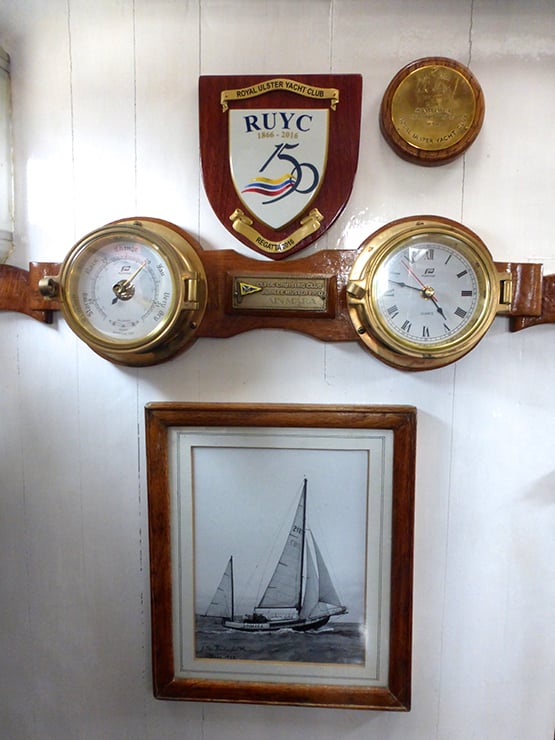
The saloon bulkhead in Ainmara now has the addition of the 150th Anniversary plaque. The medallion top right commemorates the RUYC Centenary Regatta of 1966, between the clock and the barometer is a smaller plaque commemorating participation in the Clyde Cruising Club’s Golden Jubilee Cruise-in-Company in 1969, and the photo is of Ainmara at the start of the CCC’s 1972 race from Inverness across the North Sea to Norway. Photo: W M Nixon
During those same fifty years, while Dickie kept on with Ainmara and did many things with her, including racing to Norway and cruising to the Outer Hebrides and southern Brittany and notching success in many North Channel offshore races, he also spread his wings in many other sailing directions. In 1982 he and sailing friend Brian Law built the 40ft Dick Newick trimaran Downtown Flyer with which they scored a raft of successes in events up to the international Round Britain and Ireland level, and in 1986 – in November, no less - he established a new Round Ireland Record with the 83ft catamaran Novanet. This record stood until Steve Fossett came along to snatch it with the trimaran Lakota in September 1993, and then in 1988 Dickie Gomes found himself back in mono-hulls, in command of Brian Buchanan’s Frers 49 Hesperia (she’s now Jamie Young’s Killary Flyer down in north Connemara), and was overall winner of the 1988 Round Ireland Race.
This successful relationship with Hesperia became a feature of the sailing scene for many years, and during this period Ainmara was resting in a shed at Dickie and Deirdre’s farm in the Ards Peninsula in east County Down, awaiting repairs and refurbishment after breaking from her moorings in Strangford Lough in a winter storm. But she’s a tough old bird, John Kearney built her well, she was well worth restoring, and there was never any doubt that, whatever the other distractions, she’d be sailing again for her own Centenary in 2012.
She was out and about again in 2011, her Centenary in 2012 was then marked with a celebratory cruise to the Outer Hebrides, and in 2013 she played a starring role in the Golden Jubilee Celebrations of the Old Gaffers Association, adorned with prizes too, for although Ainmara has been Bermudan-rigged since the 1930s, she’s revered as an honorary gaffer.
Tom Houlihan’s Howth 17 Zaida off Bangor. Photo: Trish Nixon
The Sesquicentennial Parade of sail was a real floating come-all-ye, with Toppers and other dinghies mixing it with Howth 17s such as the award-wining Gladys (14) and modern cruiser-racers. Photo: Betty Armstrong
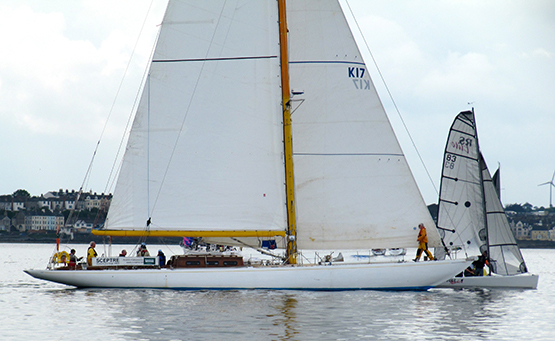
History afloat. The 1958 America’s Cup Challenger Sceptre off Bangor with an RS Elite. There’s more to this than meets the eye – the RS Elite is Phil Morrison’s miniaturized take on the special America’s Cup Class which succeeded the 12 Metres such as Sceptre as the boat of choice in AC racing. Photo: Betty Armstrong
Thus the up-coming RUYC Sesquicentennial Regatta was seen as a celebration of many things, of friendships which have withstood the test of time for many decades, of wonderful old boats which continue to give great sport, and of a surreal clubhouse which had become increasingly irrelevant as sailing’s focus shifted to smaller boats with amateur crews, but then found a new role as a sort of living museum of sailing history when Bangor was provided with what was then Ireland’s largest marina in 1991. This elevated the old clubhouse on the hill into a sort of Temple of Sailing, where devotees of the more rugged versions of the sport can retreat to reflect on their experiences in a peaceful setting well away from the hurly-burly of the marina waterfront.
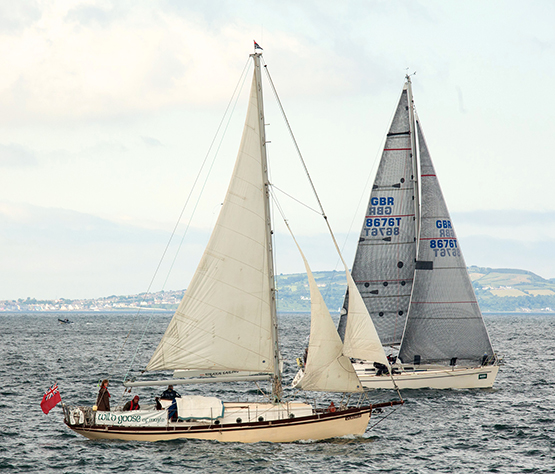
The RUYC Sesquicentennial attracted boats from every background. This is Wild Goose from Portrush, renowned in times past for her links with sailing writer Wallace Clark. She has been complete up-graded in a somewhat changed form by Robin Ruddock of Portrush, who brought her to Bangor to salute 150 years of Belfast Lough sailing. Photo: Andrew Gallagher
So how do you celebrate the 150th Anniversary of such a remarkable institution? It’s of special interest in Ireland, as we are already anticipating the 300th Anniversary of the Royal Cork Yacht Club in 2020. In Bangor, RUYC Vice Commodore Myles Lindsay and Rear Commodore Greg Taylor and their team put together an intensive four week programme which has seen a variety of events including the Sigma 33 Championship, a Classic Yacht Regatta, a 150th Anniversary Regatta which included a wide range of boats reflecting Belfast Lough and Ireland’s sailing’s diversity, while this weekend it is concluding with an assembly of the Cruising Clubs which will mercifully see the focus of activity move gracefully up the west coast of Scotland and into the Hebrides in a Cruise-in-Company which will enable them to pause for breath back in Bangor.
In tandem with this, the Hilditch Regatta at Carrickfergus drew in the Bangor-assembled boats on Thursday June 23rd for a good day of sailing, and for the first time ever it brought the Hilditch-built Howth Seventeens which had breezed in from Bangor together with the Hilditch-built (1902) Fairy Class from the Royal North of Ireland YC across the lough, plus sundry other craft including the Ainmara, without which no proper boat event in the north is complete.
Hal Sisk’s 1894-built Peggy Bawn returns to her birthplace of Carrickfergus in June 2016. Photo: Trish Nixon
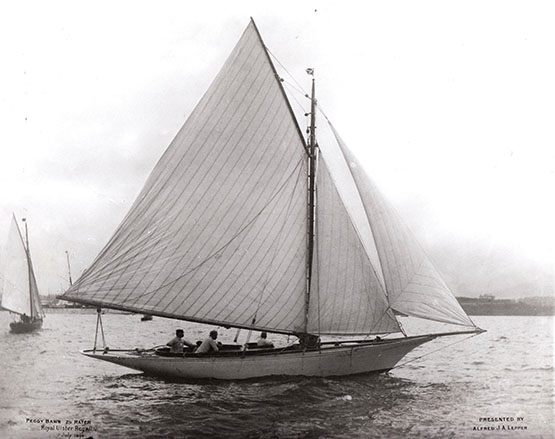
Peggy Bawn on Belfast Lough in 1894. Photo courtesy RUYC
However, by any standards the star of the show was Hal Sisk’s meticulously-restored G L Watson-designed 36ft Dun Laoghaire-based Peggy Bawn, a Hilditch-built cutter of 1894 vintage. While the Howth 17s are still as originally designed, although standards are rising every year they’re not all yet to classic yacht standards. As for the Fairy Class, they have been changed to Bermudan rig. And the old Ainmara and others like her are clearly not as originally designed. But Peggy Bawn is in a league of her own - she’s so authentic and exquisitely finished that it hurts.

Roddy Cooper’s Leila (built 1898) and the RUYC clubhouse (built 1899) get together for the first time. Photo: Betty Armstrong
The Howth Seventeens re-assembled back in Bangor to find they were seven in all, a gathering made easier - when you’ve only four road trailers - by the fact that the father of the class, Nick Massey, crewed by Dave Nixon, had sailed the 1907-built Deilginis from Howth to Bangor in two swift daylight stages, with a stop in Ardglass. They were now joined by six boats of the Glen Class which had sailed round from Strangford Lough, for although the Alfred Mylne-designed 25ft Glens – which originated in 1947 – are now found only in Strangford Lough and Dun Laoghaire, they began life as an RUYC Class, built in Bangor at the long-extinct Glen Boatyard on Smeltmill Bay to the west of the town.
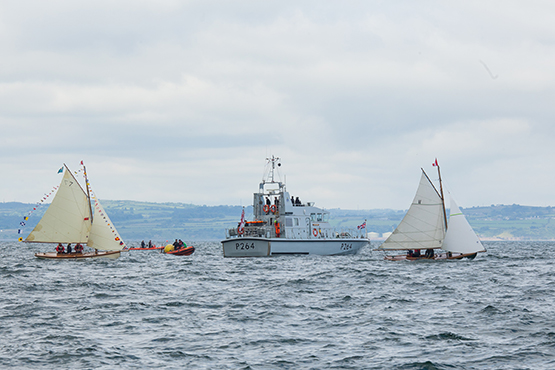
Howth 17 overall winner Aura (Ian Malcolm, left) and Deiliginis, which sailed from Howth to Bangor, parade past the guardship HMS Archer. Photo: Andrew Gallagher
Together with the restored local 18ft keelboats of the 1902 Waverley class in Bangor, there was now a comprehensive gathering of past and present to sail forth in the RUYC Sesquicentennial last Saturday. Your reporter arrived on board Ainmara in reasonable time to find the doughty skipper and his shipmate Brian Law dressing the old boat overall, while just across the pontoon was the 1958 America’s Cup Challenger, the 12 Metre Sceptre, on one of her regular outings from the north of England. And across the way was Dutch skipper Ben Korner’s Open 40 Masai, recently retired from the Volvo Round Ireland Race thanks to a broken forestay fitting, hugely frustrating as they’d been in a splendid battle through the North Channel against RORC Commodore Michael Boyd’s First 44.7 Lisa, which went on to place third overall.
At this stage of the day there still seemed a chance of some lasting sunlight, but as Ireland was plumb under the malign influence jetstream, weatherwise it was a day of everything except what you wanted. But in terms of a reunion it was perfect, as I sailed again with Dickie and Deirdre Gomes, and our crew was joined by Jervis “Jess” Fleming home in holiday from West Australia – last time we sailed together, it was on that early June cruise of 1966 in Ainmara to West Cork.
With winds fluking around between northwest and northeast and sudden gusts coming from everywhere, the water of Belfast Lough were in a horrible popple which was a death knell for Ainmara’s afternoon racing hopes, but first there was the main part of the programme, the Sesquicentennial Parade of Sail, and for that the breeze was in brisk form.
Doughty skipper Dickie Gomes (age undisclosed) takes to the bowsprit to clear Ainmara’s jib topsail, while Deirdre Gomes (back to camera) and Jervis Fleming, both of whom sailed on the boat in 1966, get ready to tail on the halyard. Photo: W M Nixon
In fact, if it hadn’t been a Parade, we wouldn’t have dreamt of sending up our jib topsail. But our doughty skipper – whose chronological age is a secret, he’s permanently 25 in apparent terms – was soon out on the bowsprit clearing it for hoisting, the motley crew got it aloft, and in the nick of time the old girl was roaring along at full chat to cross the line in top style – even her bunting looked its very best.
As for the racing, we had our moments, but were stopped still for too long, while newer boats glided ahead, to figure in any prize-worthy placings. But frustration was soon allayed by a fresh new nor’wester which we enjoyed so much we sailed an entirely superfluous circuit of the course, and then back in the berth the old saloon was so comfortable and filled with memories that we yarned well past the time when we should have been up in the club for the official events. But we touched base there in time for our skipper to get his prize as Best in Show, which was all due to that last-minute full blossoming of the jib topsail just as the old girl came roaring up to the parade area inside the Royal Navy’s HMS Archer.
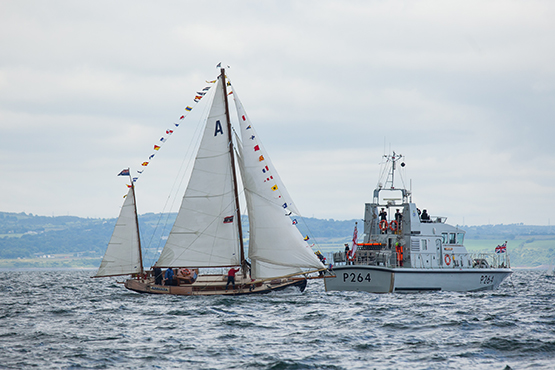
Made it in the nick of time……Everything up and drawing as Ainmara sweeps past the Guardship. Photo: Andrew Gallagher
The Howth 17 crews were made welcome and made themselves very much at home in the RUYC clubhouse. Photo: W M Nixon
So fifty years after the Centenary Regatta, Ainmara’s participation in the RUYC Sesquicentennial Regatta had hit the jackpot. The high was maintained all evening amidst much banter from the Howth 17 crowd, who had made themselves thoroughly at home in RUYC, with Ian Malcolm’s Hilditch-built Aura reckoned the best performer, though the 1907-built Gladys (Pat Heydon, Ian Byrne and Eddy Ferris) got the award for best-dressed overall. As Ian Byrne revealed, they’d gone to the trouble of putting their signal flags in the approved naval order, and these things count when you’re celebrating a 150th birthday.
The One-Designs had another day’s racing on the Sunday, but our job was done, and we’d to get Ainmara home to her secret place among the islands of Strangford Lough. As all the Howth 17s were going to be road-trailed home, Paddy Cronin with the 36ft Westerly Conway Aquarius of Howth was no longer needed as mother-ship, so we were his pilot veseel in an effortless if damp passage down the County Down coast, through Strangford Narows with the surging flood tide, and on along a winding route to Ballydorn, where the snuggest of berths was shared at the pontoon at Down Cruising Club’s lightship headquarters. It was a good end to some very special days.
The weekend comes to a close in a very special place. Ainmara with Aquarius of Howth berthed alongside the Down Cruising Club’s pontoon at its lightship headquarters at Ballydorn in Strangford Lough. Photo: W M Nixon
#RecordPerformance -Turnover at Belfast Harbour, which handles 70% of Northern Ireland’s seaborne trade and 20% of the entire island’s, rose by 3.4% to £54.3m. According to the annual report for 2015, operating profit also increased by 3.4% to stand at £28.7m. Profits before Tax rose 2.3% to £29.9m.
The report also contained details of infrastructure projects completed during the financial year totaling £18 million – up almost 40% on the previous year – and new projects totaling £100 million which are either underway or due to commence within the next six months.
Commenting on the results Dr. David Dobbin, Belfast Harbour’s Chairman said: “This has been an excellent trading year for Belfast Harbour with 23 million tonnes of cargo being handled by the Port during 2015. We’re also pleased to report on the completion and progress of a number of ambitious investments which are driving the ongoing regeneration of Belfast Harbour Estate.
“Our role is to continue to manage, maintain and develop the resources of the Harbour, and optimize outcomes for our customers and the wider regional economy. All of our earnings are re-invested in projects such as improved container and quayside handling facilities, dockside cranes or the award-winning City Quays Grade ‘A’ office development. Work is also well underway on our new film studios and we hope to announce a contractor and brand operator for a new hotel at City Quays within the coming weeks.
“These investments are resulting in new jobs and improved regional competitiveness. Belfast Harbour is committed to helping the Northern Ireland economy grow and prosper.”
2015 was the second busiest year on record for imports and exports through Belfast Harbour, reflecting its long-term policy of developing best-in-class marine facilities. This included the purchase and order of two modern pilot boats, improved Roll-On / Roll-Off handling facilities and improved bulk storage capacity for customers operating in the salt and fertiliser sectors.
Property developments progressed by Belfast Harbour included the completion of City Quays 1 (now fully let to high calibre international occupiers), the commencement of work on its 124,000 sq ft sister office, the securing of planning for a four-star hotel at City Quays and the start of work this year on a new 130,000 sq ft film studio.
Dr. Dobbin added: “The landscape of Belfast Harbour is being transformed as new marine and real estate developments come to fruition. With £100 million committed to projects which are already underway, or are in the process of securing planning such as the proposed new cruise berth, we are laying the foundations for how Belfast Harbour will look and feel for the 21st Century.
“Trade in the first quarter of 2016 has already shown encouraging signs of growth, building upon the success of our customers and the outward looking ethos of Northern Ireland’s private sector. Our expectation is that such growth will enable the Harbour to continue to support and self-fund its ambitious investment programme, creating much needed quality jobs.”
The report highlighted continued growth in Belfast’s main routes to Scotland and England with the Belfast – Liverpool Stena service recording the strongest performance with a 4% increase.
Preparatory work on a new coal processing plant also continued and the Harbour provided leases to Titanic Foundation Ltd to facilitate the restoration and conversion of the former Harland & Wolff headquarters building in Titanic Quarter into a boutique hotel.
Added to this writes Afloat is the city's newest major maritime visitor attraction the restored and unique HMS Caroline. The battle-cruiser is the last surviving ship of the 1916 Battle of Jutland.
#RNLI - Bangor RNLI assisted four people who got into difficulty on a broken-down motorboat on Belfast Lough on Monday evening (13 June).
The volunteer lifeboat crew launched at 10.25pm to rescue the 19ft motorboat just off the Cloghan Jetty.
The boat, with four people on board, had lost all power and was drifting in fog close to the shore.
Arriving at the scene, guided only by the light from a mobile phone, the crew of the relief Bangor lifeboat Tabby Cat took the motorboat under its control and returned it and its and crew safely to Carrickfergus Marina.
Speaking following the callout, Bangor RNLI helm Peter Semple said: :The crew and I are delighted that we were able to return these people to the safety of the marina. Although it was a calm night, it was dark, and Belfast Lough is not a great place to be if you can’t be seen.
"It is important to ensure that, if you lose all power you still have some way of being seen and making contact with the shore."
In other news from Bangor, the lifeboat station was recently visited by a man rescued a fortnight ago by one of its volunteers after he suffered a heart attack at sea.
Tim Bailie was on a weekend pleasure cruise between Carrickfergus and Bangor with his family at the end of May when he was taken ill.
But thanks to the quick action of helm Kyle Edwards and his crew, Bailie is still here to tell the tale in his own words, as per the video below:
#WorldsLargest - The world's most powerful tidal energy turbine writes the BBC News was assembled at Harland and Wolff shipyard in Belfast.
One of the yard's cranes, Goliath, will lower the 520-tonne structure into Belfast Lough today, Wednesday.
Each of the its twin rotor arms produces 1 megawatt of energy - enough to power thousands of homes when connected to the electricity grid.
After trials in the lough, the turbine will be used off the Orkney Islands.
The 75-metre long structure has taken a year to put together.
It will float on the water with the rotors dropped below the surface.
#BelfastLough - Work has already begun on a major new film studio lot on the shores of Belfast Lough.
According to the Belfast Telegraph, Belfast-based RPP Architects are drawing up plans for the North Foreshore Film Studios located at Giant's Park on the waterfront.
Newry firm O'Hare & McGovern has been contracted to construct the £20 million (€25.7 million) project that will comprise a sound stage and two studios with production offices.
As previously reported on Afloat.ie, the development aims to capitalise on Northern Ireland's increasing popularity as a filming location for films and TV series – most notably the worldwide hit Game of Thrones.
The Belfast Telegraph has much more on the story HERE.
Bangor Lifeboat Aids Fishermen After Engine Failure
#RNLI - Bangor RNLI’s volunteer lifeboat crew were requested by Belfast Coastguard to help two fishermen on a 17ft motorboat with engine failure.
Although conditions were calm and the crew were in no immediate danger, the westerly wind was extremely cold and blowing the fishing boat offshore.
The call to lifeboat operations manager Kevin Byers came in at 5.06pm yesterday evening (29 March) and the lifeboat launched at 5.15pm.
The lifeboat made its way to the reported position to the south of the Gobbins outside Belfast Lough, only to find the boat wasn’t there, and they were only able to locate it by radioing the boat for a position update.
On arrival, the volunteer lifeboat crew made sure the boat and crew were sound, and towed the boat to Carrickfergus Harbour, where they were thanked by an extremely grateful skipper.
Helming Tabby Cat, the temporary replacement for Bangor's regular lifeboat Jessie Hillyard, Bangor RNLI crewmember Gareth Whan said: “An incident like this emphasises the importance of good engine maintenance, particularly as many boats have been unused over the winter months.
“It also demonstrates the importance of warm clothing, as the crew of the rescued boat were extremely cold by the time we reached them – it is always much cooler on the water than it is on dry land.”
Royal Ulster Yacht Club Celebrates 150 Years of Sailing
In 2016, Royal Ulster Yacht Club is celebrating the 150th Anniversary of its formation in 1866. To mark the anniversary there will be a series of sailing and cruising events throughout the summer.
The important date was highlighted by WM Nixon last Saturday in his Afloat blog Belfast Lough Celebrates 150 Years of Organised Sailing in Style
The main focus of the year’s celebrations is around the end of June starting with the UK and Ireland National Championships of the Sigma 33 Class of yachts (17th-19th June). This event will attract sailors from around Ireland, Scotland, Isle of Man and North West England and Wales.
The following weekend the Club is running its Annual Regatta along with a Keelboat Weekend Event. The Annual Regatta is the flagship event in the club’s year and this year it will include visiting boats from Scotland, Dublin Bay and Strangford Lough to race alongside the competitors from the other yacht clubs in Belfast Lough. The day will start with a Sail Past in front of the Clubhouse and a naval Guardship will be in attendance. The visiting boats will include modern racing craft and classic boats such as the River and Glen classes from Strangford Lough some of which started life competing at Royal Ulster YC over 90 years ago. We are also expecting that several of the classic Howth 17 classes will travel north for our event.
The cruising fleet will be joining forces with similar associations such as the Irish Cruising Club and the Clyde Cruising Club for a social gathering before a cruise-in-company to Scottish waters.
The social highlight of the celebrations will be a Black Tie Gala Dinner at the Club on 1st July.
Belfast Lough Celebrates 150 Years of Organised Sailing in Style
The development of organised sailing in Ireland seems to have spread northeastwards from the south and southwest coasts. Although the great chieftain Hugh Maguire had a fleet of pleasure vessels including sailing craft on Lough Erne in County Fermanagh in the 1500s, while the noted scientific polymath Sir William Petty found a sailing “pleasure boatte” on Dublin Bay to test his catamaran Simon & Jude against in 1663, it was on Cork Harbour that we find the first formal organisation with the foundation of the Water Club in 1720 writes W M Nixon.
Before the advent of good roads, and long before the railways arrived, Ireland’s myriad waterways and lakes provided the best options for the inland transport both of goods and people, and inevitably some gentrifried working boats were also used for relaxation, and the next club to be formed was Lough Ree YC in 1770. By 1820, the world’s first club specifically organised to provide racing came into being on Lough Erne, then nearby on Lough Gill in Sligo, the Ladies’ Cup was first raced for in 1822, and it still is cometed for today, though now at Sligo YC’s sea base at Rosses Point.
In the pre-famine era before 1845, the relative affluence of the west and southwest of Ireland supported the landed classes in yacht ownership, and a regatta at Kilrush in the Shannon Estuary in 1828 saw the establishment of the Royal Western of Ireland YC, which at its height in 1838 had a fine fleet of 18 cutters – some of quite substantial size - based in Kilrush Creek and spreading outwards to families along the coast such as the O’Connells of Tralee, Cahirsiveen and Derrynane.

The Game Changer. Dun Laoghaire’s first regatta in 1828 set Dublin Bay on course to be the pace-setter in yachting development.
But 1828 also saw the first regatta to be staged at the new harbour of Kingstown on Dublin Bay, and the success of this provided an unrivalled focus for the development of new ideas in sailing not only in Ireland, but at an international level. Whereas other sailing area saw the locations of activity spread across several centres large and small, in Dublin Bay there was just this one big powerhouse of sailing development through which all the recreational nautical energy of the capital city was channeled. The Royal Irish YC came into being in 1831, the Royal St George YC got going in 1838, and soon Kingstown outstripped most comparable centres at home and abroad, particularly in racing development.
Yet at this time Belfast was already the fastest-expanding city in Ireland, and it was moreover a growing centre of genuine wealth-creating manufacturing industries and ship-building enterprises. Why wasn’t Belfast Lough in the forefront of sailing development by the 1850s?
It wasn’t as though there wasn’t a small but time-honoured local recreational sailing tradition on Belfast Lough. During the 1780s and 1790s, Belfast had been a place of liberal ideas and social innovation, and a small group of recreational sailors led by Henry Joy McCracken pioneered cruising from Belfast Lough to the west coast of Scotland and the Hebrides. But then in 1798 McCracken also led the rising of the United Irishmen, and when it was suppressed he was executed by hanging in the Cornmarket in Belfast on land which his grandfather had donated to the town.
Subsequently, the Presbyterian majority in the north turned in on themselves and concentrated on commerce and manufacture and literally minding their own business. But though, as prosperity returned, a small group of McCracken’s former shipmates formed the Northern Yacht Club in Belfast Lough in 1824, Belfast’s rapid industrial expansion made the port very limited as a yacht harbour, thereby limiting their growth.
Belfast Lough may have provided splendid sailing water, but it was very poorly served by other smaller harbours, so the Northern Yacht Club members often found themselves sailing to the more congenial and well-serviced shores of the Firth of Clyde. They soon formed a Scottish branch, and by 1838 the Royal Northern Yacht Club - as it was to become, with an impressive clubhouse in Rothesay - had taken over the few remaining assets of the Belfast Lough branch, and that was the end of any club in the Lough for another quarter century.
Yet any student of sailing history will know that in 1856, Lord Dufferin from Clandeboye near Bangor on the shores of Belfast Lough made a celebrated voyage to the high Arctic with his schooner Foam. And in 1865, one of the most successful racing schooners of all time, the 99ft Egeria, was built for leading Belfast linen manufacturing magnate John Mulholland. So why wasn’t Belfast Lough sharing the sailing fame of other Irish centres such as Dublin Bay and Cork Harbour, which had shown their pre-eminence by staging the world’s first recognisably modern offshore race from Dublin Bay to Cork Harbour in 1860?
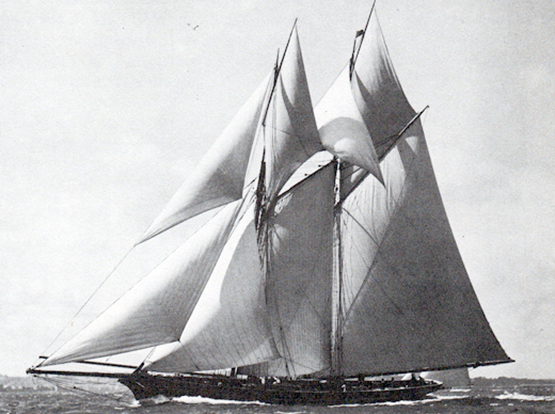
The extremely successful racing schooner Egeria was built for Belfast business magnate John Mulholland in 1865, but she was seldom if ever in Belfast Lough
The simple answer seems to be that in its period of hyper-growth, the business of Belfast was business, and sailing for recreation was not a Belfast business. Those who expected to sail at the highest level did so elsewhere, and once the Belfast to Dublin railway had been connected in 1855, it was as handy for the more affluent would-be yachtsmen to avail of the proper facilities in Dublin Bay rather than risk their yachts on exposed moorings in Belfast Lough, where shore facilities were still woefully lacking.
But in time the rapid rise of an energetic middle class in Belfast saw increasing demand for sailing amenities and events nearer home. We know that a regatta of some sort was staged at Holywood immediately east of Belfast on the lough’s south shore in 1854, and it was at Holywood – despite the little town’s drying anchorage – that the first club since the Northern YC in 1824, the Hoywood Yacht Club – was formed in 1862, and it still exists, Belfast Lough’s senior club.
Then in 1866 a regatta was staged from the only half decent harbour on the lough, at Carrickfergus, and the organisers were pleasantly surprised by the number of boats which turned out, boats whose owners had squirrelled out bits of shelter for their craft in small places like Donaghadee, Groomsport, the tiny drying harbour at Bangor, in the open roadstead off Cultra, in the cleaner parts of Belfast docks, in Carrickfergus itself, and round the corner in Larne Lough.
From this there immediately emerged the Carrickfergus Amateur Rowing & Sailing Club, but mostly to cater for local demand. But soon afterwards in Belfast the Ulster Yacht Club was formed by a group of affluent businessmen, professionals, industrialists and landowners with Lord Dufferin as their Commodore. By 1869 he’d seen to it that they’d become the Royal Ulster Yacht Club, but it was an organisation which was resolutely to function without a clubhouse until 1899, nevertheless growing in prestige with every passing year.
Thanks to that focus of interest through the Carrickfergus Regatta of 1866, 2016 will see double celebrations on Belfast Lough with the 150th Anniversaries of both Carrickfergus Amateur Rowing and Sailing Club (which everyone knows as Carrick Sailing Club), and the Royal Ulster Yacht Club, which since April 1899 has been based in an impressive Arts & Crafts clubhouse on an eminence above Bangor’s waterfront.

The RUYC clubhouse was built in 18 months and opened in 1899 in order to be ready for Thomas Lipton’s first America’s Cup campaign
When the clubhouse was built, the harbour at Bangor was still rudimentary, but the sailing was great. However, since 1984 Bangor Bay has been turned into one of Ireland’s largest marinas, and now RUYC has the berthing facilities and the sailing water to stage major events with confidence.

Befast Lough provides excellent sailing water, but until the marina were built at Carrickfergus and Bangor, it lacked sheltered berthing

Carrickfergus Marina, with the harbour and its famous 12th Century castle beyond
Equally at Carrickfergus they also have a marina – in fact it pre-dates the one at Bangor – but as Carrickfergus was also the base of the extraordinarily productive yachtbuilder John Hilditch, albeit only from 1889 to 1913, one of the main parts of their celebration is going to be a Hilditch Regatta, not just for boats built by him such as Hal Sisk’s famous 1894 Watson cutter Peggy Bawn, the Howth 17s of 1898, and the RNIYC Fairy Class of 1901, but indeed for any classic or traditional craft, as Carrick has always been a spiritual home for the Old Gaffers Association.

Bangor Marina, with Ballyholme Bay beyond
Royal Ulster has meanwhile taken a different track through sailing history, for between 1899 and 1931, it was the club through which Thomas Lipton made his five America’s Cup Challenges, which has tended to obscure the fact that in the 1880s and 1890s, Belfast Lough with RUYC in a key role were setting a fantastic pace in sailing development, as they were trying to get a one design keelboat class going as long ago as 1889, and by 1895 they’d brought the Belfast Lough One Design Association into being with a determined young sailing man called James Craig as Honorary Secretary. Membership of the BLODA was open to any member of one of the recognised six clubs now based round the lough, but young Craig – who later went on to become Lord Craigavon, first Prime Minister of Northern Ireland in 1921 – was realistic in his expectations for the life of a strict one design keelboat class, and he only expected his members to be “in class” for three seasons.
By 1896 they’d the first two boats of a new 15ft LWL keelboat class designed by William Fife, no less, sailing on Belfast Lough, and before the summer was out the signs were good for a significant increase in numbers for 1897. James Craig was insisting the boats be built by John Hilditch, as he was noted for sticking strictly to the plans as drawn by the designer, whereas the builder of the first two boats for 1896, Paddy McKeown in the heart of Belfast, was always trying to improve on the designs, even if they were from Fife.

Regatta day for the Dublin Bay 25s – their design was inspired by the Befast Lough Class I boats.
But events overtook the programme. A group of affluent Belfast Lough movers and shakers decided they certainly wanted a One-Design class to the Belfast Lough ODA rules and designed by William Fife, but they wanted a proper sea-going boats with a cabin, around 37ft in hull overall length, and 25ft on the waterline, and setting a proper gaff rig with a jackard topsail rather than the modest little gunter rig set by the 15ft LWL boats, which were still referred to as Class I.
But as the idea for the bigger boats gained traction, they became Class I, and for a while the 15ft LWL boats became Class II, but after 1900 they were Class III when a 20ft LWL class came along. But meanwhile in late 1896 and early 1897, the Hilditch yard went mad, building nine of the new 25ft LWL boats. Even Lord Dufferin and his friends Lord de Ros and Lord Bangor came round from County Down in April 1897 to the tough town of Carrickfergus to see this remarkable new class of boats being built. And once the 25 footer had their first race off Carrickfergus on May 29th , they swung into action with what today would be called a series of promotional tours, as they did all of Clyde Fortnight after a stormy crossing of the North Channel, and then after being back in Belfast Lough for long enough to race the RUYC regatta, they headed south to Dublin Bay in late July and inspired the creation of the Dublin Bay 25 class.
1898 was when they were in their prime, and by 1899 some owners were aready invoking the “three season” rule to move on, but in fact the class continued to race actively – though sometimes with very depleted numbers – on Belfast Lough until the end of the 1909 season.

John Hilditch was very busy in 1897 – in addition to the Belfast Lough Class I boats, his yard also built this 56ft motoryacht Romance for A J Lepper, for whom he’d built Peggy Bawn in 1894.
We get some idea of the boat-building pace around Carrickfergus in the late 1890s when we realise that in 1897 John Hilditch and his men were also building a 57ft Dixon Kemp motor-yacht, the Romance, for A J Lepper, for whom they’d built Peggy Bawn so well in 1894, and no sooner was the Romance out of the way than they turned to the next job, the building of the first five Howth 17s which their owners were able to sail the 90 miles to their home port in April 1898.
So obviously there’s going to be quite a complicated programme around Belfast Lough in late June and early July this year. And as the Howth 17s are in the unique position of being a Hilditch class which is not Belfast Lough-based, they hope to be able to pay their respects at Carickfergus both to the memory of their builder and to the 150th Anniversary of the Carrickfergus club, while also being able to do full justice to the Classic One Designs Regatta, which RUYC will be staging from Friday June 24th to Sunday June 26th.
The Hilditch Regatta meanwhile is from the evening of Wednesday June 22nd to Saturday June 23rd, when the fleet heads from Carrickferus to Bangor for a sail-past as part of the Royal Ulster events, but with some of the Old Gaffers then returning to Carrick (after due celebrations in Bangor) as the Carrick event is seen partially as a follow-on to the Portaferry Sails & Sounds the previous weekend, which is very much an Old Gaffers event.
In Carrickfergus are (left to right) Nick Massey, Roddy Cooper, Tom Houlihan, CSC Commodore Wendy Moore, and Ian Malcolm. Photo: W M Nixon
But for classes like the Howth 17s, despite their antiquity proper racing is what it’s all about, so I tagged along with a reconnaissance group of Howth 17 eminences when they went up North to suss out the scene this week. And as the group included Nick Massey who re-energised the class when it was going through a flakey period in 1972, Ian Malcolm who is playing a key role in the class’s current revival such that they’ll have eighteen boats racing this year, Roddy Cooper who owns the Hilditch-built Leila, and Class Captain Dr Tom Houlihan, you can be quite sure there wasn’t a dull moment.
First call was with Wendy Moore at Carrickfergus, where she’s Commodore for the 150th as the club settle into the new clubhouse after a disastrous fire three years ago, and as she’s also the Marina/Boatyard Manager and the newest addition to the ranks of owners in the local thriving Ruffian 23 class, everyone was on the same wavelength.

You’ll always find it’s now in a carpark….Roddy Cooper and Ian Malcolm stand on the spot where their Howth 17s Leila and Aura were built in 1898, with Carrickfergus Castle in the background. Photo: W M Nixon
Then we swung by Royal North of Ireland Yacht Club at Cultra on the south shore of the lough, home to the Hilditch-built Fairy class against whom the Howth crowd regularly have inter-club races, and fortuitously met up with Northern Ireland Old Gaffers Association Chairman Gary Lyons for some very high-powered info exchange. As a result we round out this week’s blog with a photo which does justice to the Portaferry Sails & Sounds which he is organising in June.
Then on in haste for a sailing business lunch (delicious) at Royal Ulster YC with Vice Commodore Myles Lindsay, Rear Commodore Greg Taylor, Honorary Sailing Secretary Robin McKelvey and Press Officer Fiona Hicks, learning yet again that the RUYC clubhouse is such a store of sailing memorabilia that it’s a difffcult to concentrate on the formal agenda, but I think the Howth men and the Bangor men understood each other very well indeed.

Myles Lindsay, Vice Commodore RUYC

Robin McKelvey, Honorary Sailing Secretary RUYC
The RUYC people have a lot on their plate, for no sooner is the Classics Regatta out of the way than they gear up at the beginning of July for an assembly in Bangor of cruising boats from the ICC, the RCC, the OCC, the CCC and other associated organisations, followed by a 150th Anniversary Cruise-in-Company along the Antrim coast and on to the West Coast of Scotland and the Hebrides.
But for the recce group from Howth, now it was down to Bangor Marina where manager Kevin Baird couldn’t have been more obliging, but the Howth 17 men all fell in love with the classic ketch Morna berthed right next to the marina office, so Fiona and I had to speed them on their way to the exhibition of 150 Years of sailing in Bangor Museum.
The classic ketch Morna in Bangor Marina. Photo: W M Nixon
And then after that, duty done and work completed, I took them for the treat of the day, down among the hidden places of Strangford Lough to meet up with Kenny Smyth at his boatyard, which for any one who is into classic, vintage or traditional boats is heaven on earth. And of course it emerged that Kenny the King of the River Class, Whiterock’s historic Mylne-designed premier fleet, has recently become Commodore of Strangford Lough Yacht Club. So we headed for home into a gorgeous sunset having notched up two Commodores, one Vice Commodore, one Rear Commodore, one Chairman, one Honorary Sailing Secretary, two Marina Managers and one Press Officer. And if that’s not a good day’s work on the diplomacy and negotiating front, then I don’t know what is.
The eternal enthusiast. Kenny Smyth of Whiterock runs a boatyard, he is also Commodore of Strangford Lough Yacht Club, he is River Class champion, and he just loves talking about boats night and day. Photo: W M Nixon
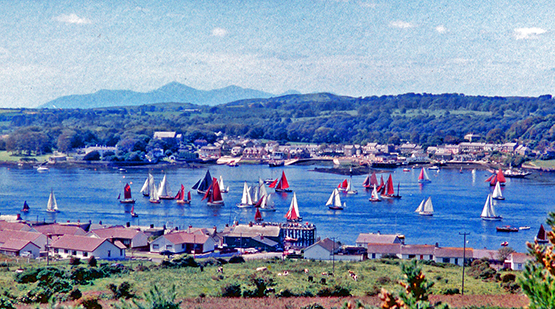
The promise of summer – the classic and traditional season in the north starts with Portaferry Sails and Sounds on June 16th.
New Waterside 'Apartments' For Special Belfast Lough Residents
#BelfastLough - Belfast Harbour has announced the completion of its latest waterside apartments - but you may have to look close to see them, as they were created for some very special residents.
Indeed, as you can see from the tweet below, the wooden nesting boxes installed beneath a harbour pier are just the right size for the harbour's nesting guillemots.
Here's to a happy new home for some of Belfast's most striking marine wildlife!
Construction just finished on our new waterside apartments. Created for v special residents-the Harbour's Guillemots pic.twitter.com/LrJYpWR5cF
— Belfast Harbour (@BelfastHarbour) March 15, 2016
#BelfastLough - Giant's Park on the North Foreshore of Belfast Lough is set to be the location of a new film studio, according to BBC News.
The circa £14 million development aims to capitalise on Northern Ireland's increasing popularity as a filming location for hit TV series like Game of Thrones and films such as the Brad Pitt-produced The Lost City of Z.
Belfast City Council heard that hundreds of jobs could be created in the construction and operation of the studio, earmarked for the former landfill waterfront site.
In other news, a 19th-century chapel overlooking Giant's Park with stunning views over Belfast Lough is on the market as part of a 'unique' residential development.
Built by the third Marquis of Donegall in the mid-1800s, the former Chapel of the Resurrection was extensively renovated in the 1980s and is now part of a package of zoned housing lands in a very desirable part of North Belfast, as the Belfast Telegraph reports.


